Scale Sequences: Fire Up Your Solos with 15 Mind-Blowing Patterns
Take a look at the power of sequencing patterns and explore ways you can put them to use to ignite your solos and licks with a new intensity.
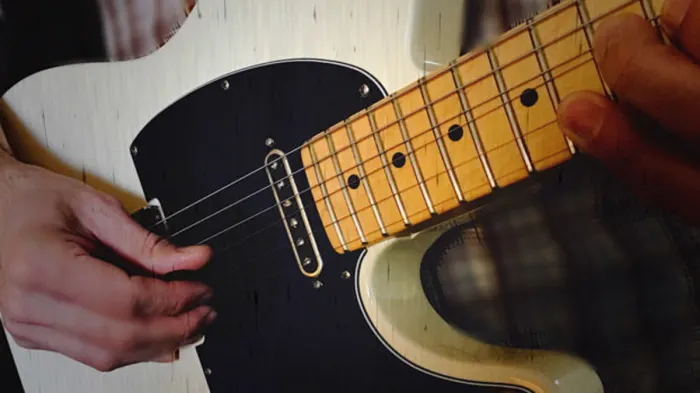
If you’re a guitarist who loves to practice, you’re probably well acquainted with a scale sequence or two.
But if you think they’re best left for the practice room, think again. The fiery solos of hard rock are laced with 16th-note scale sequences - think Ritchie Blackmore, Randy Rhoads, Uli Jon Roth, Michael Schenker, John Petrucci, Paul Gilbert, Eric Johnson, Yngwie Malmsteen and Vinnie Moore.
Jazz and fusion guitarists - including Django Reinhardt, Joe Pass, Joe Diorio, John Scofield and Frank Gambale - employ a wide variety of arpeggio and sequence-triad patterns. Intervallic sequences also abound in the country stylings of Albert Lee, Brent Mason and Danny Gatton, and the blues idiom is peppered with triplet-based sequences.
Under the circumstances, it’s obvious that there is a lot we can learn from the abundant use of sequencing patterns.
In this lesson, we’ll take a look at the power of these patterns and explore ways you can put them to use to ignite your solos and licks with a new intensity. Once we’ve run through the basics, we’ll apply them to a written solo to see how they can be used in real-life situations.
Scale Sequences
Just what is a scale sequence?
Traditionally, a scale sequence is a specific pattern of notes, usually two to four, that is repeated at various starting points within the same scale. Take a look at FIGURE 1A, which depicts the popular groups-of-four sequence.
FIGURE 1A
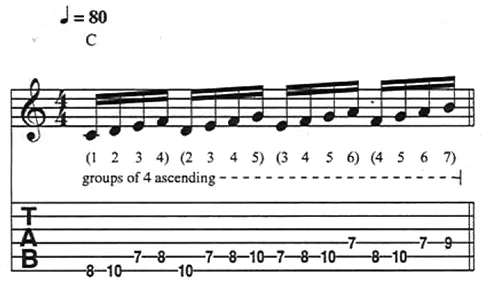
This example begins by ascending the first four notes of the C major scale (C D E F), at which point the pattern repeats, only starting this time on the second degree of the scale, D. The next repeat of the pattern starts on the third degree, E and so on.
This sequence can be applied to any scale or mode simply by following the diatonic scale degrees 1-2-3-4, 2-3-4-5, 3-4-5-6 and so forth,
FIGURE 1B depicts the descending form of the groups-of-four sequence, this time applied to the C minor scale (C-D-Eb-F-G-Ab-Bb). Starting from the root, C, the four-note pattern descends the scale as follows 1(8)-b7-b6-5 (C-Bb-Ab-G); b7-b6-5-4 (Bb-Ab-G-F); b6-5-4-b3 (Ab-G-F-Eb) and so on.
FIGURE 1B
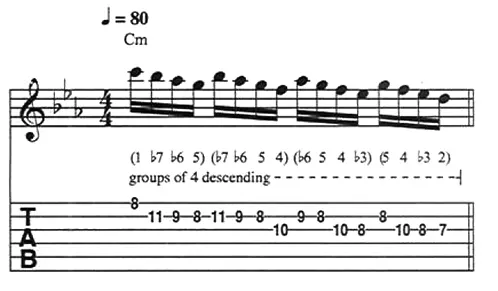
Another common scale sequence is the triplet-based groups-of-three pattern. FIGURE 2A offers an examples of the ascending version, drawing on the A Dorian mode (A-B-C-D-E-F#-G).
FIGURE 2A
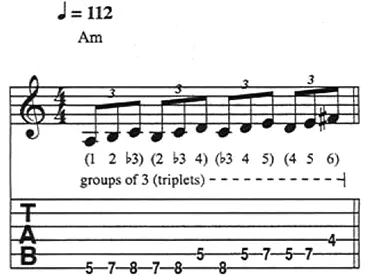
FIGURE 2B descends the E Mixolydian mode (E-F#-G#-A-B-C#-D) via the groups-of-three sequence. This time, however, the triplets are converted to eighth notes, offering a rhythmic offset: triple meter superimposed over duple meter.
FIGURE 2B
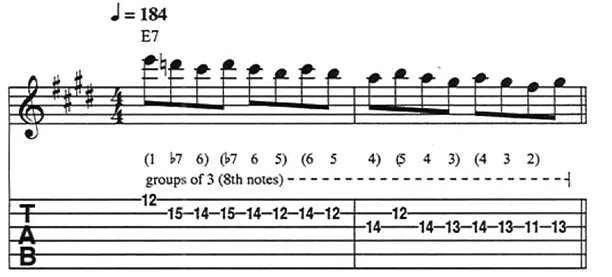
Try applying these sequences to your favorite scale patterns. And don’t feel that you always have to start the sequence from the root of the scale - sometimes it’s desirable to begin from another scale tone.
Here are a few more sequences you might want to try,
1-2-3-1, 2-3-4-2, 3-4-5-3, etc.
1-2-3-4-5, 2-3-4-5-6, 3-4-5-6-7, etc.
1-2-3-4-3, 2-3-4-5-4, 3-4-5-6-5, etc.
1-2-3-4-5-4-3, 2-3-4-5-6-5-4, 3-4-5-6-7-6-5,etc.
1-7-1-2-3-4, 2-1-2-3-4-5, 3-2-3-4-5-6, etc.
Scale sequences can also be applied to nondiatonic scales, such as major and minor pentatonics. Check out FIGURES 3A-B for some intriguing possibilities.
FIGURES 3A
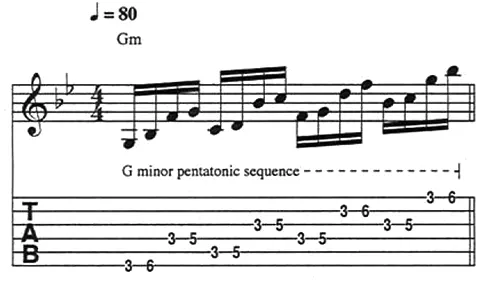
FIGURES 3B

Intervallic Sequences
It’s also common practice to apply sequences to diatonic intervals. Perhaps the most useful of these is the diatonic 3rd variety - a pattern that ascends in an “up two (scale steps), back one” theme.
FIGURE 4A illustrates this process using the C major scale (C-D-E-F-G-A-B). The formula for ascension is 1-3, 2-4, 3-5, 4-6, etc. Descension goes as follows: 1(8)-6, 7-5, 6-4, 5-4, etc.
FIGURE 4A
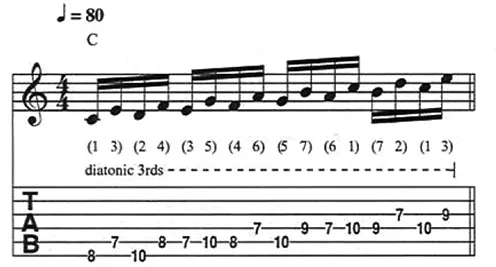
FIGURE 4B is a sawtooth sequence of 3rds applied to the C major scale. The sawtooth sequence starts out the same as the diatonic 3rds (1-3) but then goes up one scale step and back down a diatonic 3rd: 1-3-4-2, 3-5-6-4, 5-7-1(8)-6, etc., when ascending, and 1(8)-6-5-7, 6-4-3-5, 4-2-1-3, etc., when descending.
FIGURE 4B
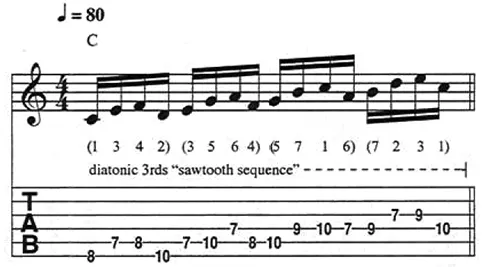
You can rack up a lot of melodic mileage by combining these 3rds sequences with other scale patterns and modes.
And while you’re at it, try experimenting with other combinations of intervals. FIGURE 5 shows a descending sequence of diatonic 4ths (a common move in jazz) within the A Dorian mode.
FIGURE 5
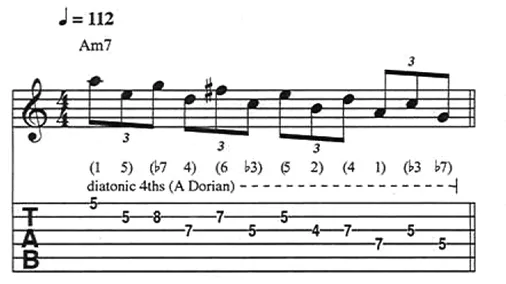
FIGURE 6 is a sawtooth sequence of diatonic 5ths (a popular fusion technique) descending the D Mixolydian mode (D-E-F#-G-A-B-C).
FIGURE 6
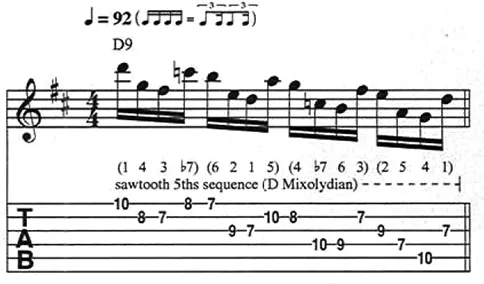
Triad and Arpeggio Sequences
Many scale-sequence patterns can also be applied to triads and basic 7th arpeggios. FIGURE 7 ascends the G major scale via a sawtooth sequence of harmonized triads. The pattern simply rolls up one triad (from the root) and then down the other (from the 5th), in diatonic succession (G-Am-Bm-C-D-Em-B˚) up the scale pattern.
FIGURE 7
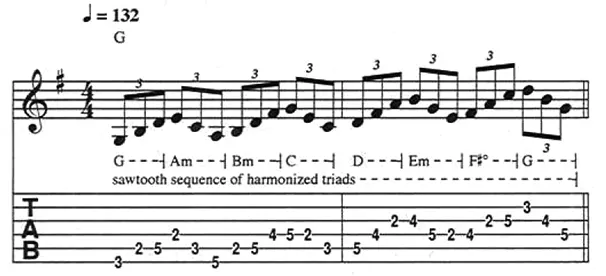
FIGURE 8 applies an interesting sequence to an Em7b5 arpeggio (used as a substitute over a C7 chord).
FIGURE 8
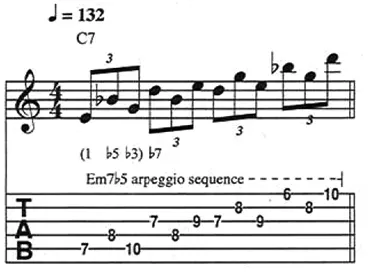
Inspired by the diatonic 3rds sequence in FIGURE 4A, it skips every other note as it gradually climbs the arpeggio. Other patterns that lend themselves well to arpeggios are the groups-of-four (FIGURES 1A-B) and groups-of-three (FIGURES 2A-B) sequences.
The Solo
The style for this solo (FIGURE 9) is hard-driving rock. Written in the key of A minor, it’s a 16-bar progression constructed from two similar eight-bar sections. Both start with a i–bVI-iv (Am-F-Dm) passage, but the first section ends on a i-bVII (Am-G) turnaround, whereas the second goes out on a V7-i (E7-Am) cadence.
The solo opens with a groups-of-three sequence that descends the A minor scale (A-B-C-D-E-F-G) from C to G. Notice how the rhythmic variation - half note, eighth-note rest and tied eighth notes - and the staccato accents break up the predictability of the sequence.
In measure 3, F Lydian (F-G-A-B-C-D-E) is dispatched to mark the arrival of the bVI chord (F). The groups-of-three theme is maintained but camouflaged by two rhythmic motifs. The first follows a scheme of a dotted-quarter note and two 16th notes (measure 3), while the second exploits a grouping of an eighth note and two 16th notes (measure 4).
Measures 6–7 host an ascending Dm7 arpeggio (D-F-A-C) based on the sequence in FIGURE 8. Notice how the rhythms reflect the motif activity from measures 4–5.
Measures 7–8 put a descending wrap on the first section with a sequenced Am7 arpeggio (A-C-E-G) followed by a straight-ahead groups-of-four sequence that slides down the G Mixolydian mode (G-A-B-C-D-E-F).
The second section opens with an eighth-note-triplet theme (measures 9–10), which creates considerable rhythmic intensity against the driving, steady eighth-note groove. The A minor scale supplies the melodic fuel for both the harmonized triad passage and the subsequent diatonic 6ths sequence.
The rhythmic tension is released in measure 11, where a pair of figures - rhythmically, a quarter note, a 16th rest and three 16th notes - slot themselves into the meter. A back-pedaling sequence (1-5-7-5, 3-1-3-1,5) employing an Fmaj7 arpeggio (F-A-C-E) provides melodic anticipation, which is heightened by the arrival of a galloping groups-of-three sequence in measure 12.
In measure 13, an economic melody based on D Dorian (D-E-F-G-A-B-C) allows for a momentary breath before the solo goes out with a go-for-broke set of incendiary sequences that zip down the A harmonic minor (A-B-C-D-E-F-G#) scale and then up the A natural minor scale.
FIGURE 9






Get The Pick Newsletter
All the latest guitar news, interviews, lessons, reviews, deals and more, direct to your inbox!
Guitar Player is the world’s most comprehensive, trusted and insightful guitar publication for passionate guitarists and active musicians of all ages. Guitar Player magazine is published 13 times a year in print and digital formats. The magazine was established in 1967 and is the world's oldest guitar magazine. When "Guitar Player Staff" is credited as the author, it's usually because more than one author on the team has created the story.
“Write for five minutes a day. I mean, who can’t manage that?” Mike Stern's top five guitar tips include one simple fix to help you develop your personal guitar style
"It’s like you’re making a statement. And you never know where it’ll lead." Pete Thorn shares the tip that convinced Joe Satriani he was the right guitarist for the SatchVai Band










